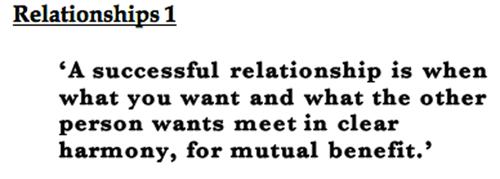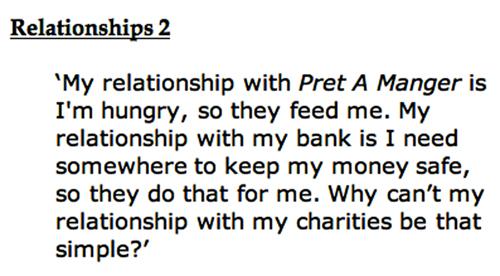Forcing or forging a relationship? Part 1: understanding your donors
This, the first of a three-part feature by Charlie Hulme, managing director, DonorVoice UK, kicks off an important new series for SOFII. Based upon evidence and experience rather than theory and opinion, Charlie’s first article spells out the crucial necessity of really understanding what your donors want from their relationship with you and your cause. The second article, ‘How to measure a relationship’, challenges our assumptions about the value of supporter service and leads into the final part, ‘How to manage a relationship’, which unites all three parts in a constructive and positive view of how our sector might truly implement relationship fundraising in practice.
- Written by
- Charlie Hulme
- Added
- September 30, 2014
The cost of just guessing

Thanks for taking the time to read this when, I’m sure, you’re very busy. But can you be sure how productive you are? Of all the areas where you are spending time and money do you know which actually matter to your donors, and their relationship with you, and which don’t? Do you know those that are forming and forging a relationship and those that are harming it?
Of course it’s easy to say campaign X was outperformed by campaign Y. But can you say, precisely, how campaign X affected the way donors felt about campaign Y? Impossible, isn’t it? And that’s just a single campaign run by a single department. What happens when you throw everything else you and the rest of your organisation do into the mix? Can you say what’s actually causing a donor’s relationship with you to flourish and what isn’t?
No. And nor can anyone else. All we can do is guess.
‘Guesswork is very expensive’

So says the father of scientific advertising, Claude C Hopkins. Here is a pioneer of techniques that have generated untold billions in income who frankly admits ‘…it is hard to measure human idiosyncrasies, the preferences and prejudices, the likes and dislikes that exist’.
But imagine if, instead of guessing, you could plan your strategy knowing precisely the ‘preferences and prejudices, the likes and dislikes’ of your donors. That not only could you measure the strength of their relationship with you, but you could also influence it by knowing exactly what to say and what not.
Sound like science fiction? Well it is a science but there’s no fiction. This short series of articles will present findings from a ground-breaking study into donor commitment with over 250 charities in the USA, UK, Canada, Australia and Europe. The study was conducted by DonorVoice, the first and only organisation to build an empirical model that measures what influences the strength of a relationship. The findings are nothing short of revolutionary. You will see that it’s possible to discover what it is about your current programme that matters most to your supporters and how it relates to the rest of their lives.
Let me state that again: you can find out exactly what matters to your donors and fix, scale, or ditch accordingly.
Or you can keep guessing.
The findings of this remarkable study could not be timelier. Our sector is at a crossroads; cost of acquisition is soaring whilst retention is falling rapidly. It can take a couple of years before a donor’s gift so much as covers the cost of his or her acquisition. And that’s those who stick around, which the vast majority don’t.
I know you know this, after all our sector’s never enjoyed great retention. The glory days that too many wistfully recall are not those when most donors were loyal but those when replacement was cheap, so we thought we could afford to ignore the fact that so many of them were leaving. Ken Burnett and Adrian Sargeant published masterly works on donor relationships many years ago. They all but pleaded with fundraisers everywhere to wake up to the fact that it’s far more profitable to retain an existing donor than to recruit a new one. Yet, based on our actions, an outsider would be forgiven for assuming fundraising was 100 per cent synonymous with acquisition.
The net result is we are collectively spending and losing billions year on year replacing donors that we should never have lost in the first place. There’s huge churn but very little change. This study transforms that.
But it does something even more remarkable. It finds enormous amounts of additional income we never even knew was available. Across all 250+ international organisations that DonorVoice worked with we found they were losing out on an enormous increase in lifetime value averaging 131 per cent – this is not a typo – simply because, when they’re defining loyalty, they’re measuring the wrong thing.
So how should you define and measure loyalty?
Ask any fundraiser to define a loyal donor and more often than not you’ll hear some variation on the recency, frequency and value of their donations. So common is this definition that it’s widely known as ‘RFV’ (RFM in the USA and Canada) and accepted as best practice. But take a close look at the equation we’ve been using for so long:
Transactional variables = Good/loyal
Anything seem odd about it to you?
No?
Look again please… Have you noticed both sides of the equals sign are outcomes? Our ‘best’ practice is all effect with no cause. By our own definition our best donors are our best donors because they’re our best donors!
The only strategy this tautological methodology allows is to pump enough stuff through enough channels in the hope enough people will give. It’s a staggeringly inefficient and costly race to the middle followedby a plummet to the bottom.
It’s no wonder individual giving hasn’t grown in decades. All this time we’ve called ourselves ‘relationship’ fundraisers when all our methodology has allowed us to be is transactional ones!
So let’s take a look at the word ‘relationship’. What does it mean?

The Oxford dictionary defines relationship as:
‘The way in which two or more people or things are connected, or the state of being connected.’
Quite a matter of fact word isn’t it? Yet ‘relationship’ in our sector has come to mean something warm and fluffy. There’s a prevalent school of thought that says all we need to do to keep donors loyal is ‘surprise and delight’ them. Have you ever tried such a programme? I’d be surprised if you were delighted with the results.
Many charities, perhaps yours included, have invested time, resource and money in poorly constructed loyalty schemes that do little more than replace some asks with non-cash thank yous. But where is the evidence to prove these programmes actually work? There are countless examples to show they don’t. In every instance I’ve seen retention has always got worse after the loyalty programme was run.
One British household name charity ran an eight-year split test. One group of donors got the standard fundraising track, the other the same but interwoven with a ‘thank you’ now and then: calls, postcards, letters with no ask, just thanks. What happened? After eight years retention in both groups was all but identical, slightly worse in the ‘thank-you’ group, but not statistically significant. Not only had a huge amount of time, effort and money been wasted on the programme but think of the opportunity and possible donations they missed by not asking for money.
Now, please don’t get me wrong: saying ‘thank you’ and showing outcomes is enormously important. ‘Thank you’, along with ‘please’ is one of the most important phrases in any successful fundraisers lexicon.
But we have to mean it.
Ever since Ken Burnett’s brilliant study of relationship fundraising in action, Friends for Life, was published in 1996 most charities realise that a ‘thank you’ months after the fact really isn’t a thank you at all. But all too often in our rush to get our ‘thank you’ out we neglect to say it properly. Time and again in our work with charities around the world I’ve seen responses from donors that say charity X does a good job of saying thank you, but a bad job of making them feel thanked. You can’t fake sincerity.
Moreover there’s a question of consistency. If in one letter/phone call/email we tell them how much they’ve achieved and in the next we tell them we are struggling and urgently need their help which are they to believe?
The inherent flaw with this overly simplistic mind-set is that it makes fundraising about asking for money and fund maintenance and growth about showing outcomes and saying thank you. That formula allows us to do neither well. It’s yet another ‘best’ practice that is making things worse.
So what’s the alternative?
To admit donor behaviour is beyond our control. What we do control is what we send them, which dictates how they think and feel about us. Those thoughts and feelings in turn dictate what they do.
Makes sense doesn’t it? This is the first of a series of three articles. I have no power to make you read the following two. My hope is that you’ve found what you’ve read so far useful and so want to learn more. That there’s a connection between what you need and what I’m writing about. On that basis we have the makings of a relationship. The alternative is I take your having read this article as unswerving loyalty and inundate you with everything I ever write for the next decade or more regardless of your interest.
So how does this help you? You already know that you’d do things differently if you knew what your donors thought and felt. It’s intuitive. It’s also impossible. At least, it was until very recently.
In ‘forcing or forging a relationship part two: how to measure and manage a relationship’ I’ll show you exactly how you can break down the component parts of a relationship. You’ll learn how to define them, how to measure them and how to influence them. With that knowledge you’ll be able to start forging relationships instead of forcing them.
© Charlie Hulme 2014.
















